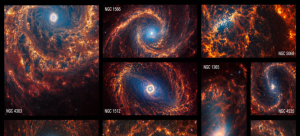
MELBOURNE, 2 February 2024: Gene Roddenberry’s Star Trek (late 60s) TV series generated global interest in space, the last frontier. The never ending curiosity consolidated earlier when the Soviet Union’s Yuri Gagarin in April 1961 became the first human to travel into space.
“Yuri Gagarin from the Soviet Union was the first human in space. His vehicle, Vostok 1 circled Earth at a speed of 27,400 kilometers per hour with the flight lasting 108 minutes. Vostok’s reentry was controlled by a computer. Unlike the early U.S. human spaceflight programs, Gagarin did not land inside of capsule. Instead, he ejected from the spacecraft and landed by parachute” (nasa.gov).
Star Trek’s iconic prologue still resonates – “Space: the final frontier. These are the voyages of the starship Enterprise. Its five-year mission: To explore strange new worlds, to seek out new life and new civilizations, to boldly go where no man has gone before.”

The space race is still on and each day new information comes up. A new treasure trove of Webb images has arrived! Near- and mid-infrared images show off every facet of these face-on spiral galaxies.
Humanity has spent centuries mapping Earth’s features – and we frequently repeat the process by using more advanced instruments. When we combine the data, we get a more complete understanding of our planet.
Now, look outward into space. Astronomers have observed nearby, face-on spiral galaxies for decades. Both space- and ground-based telescopes have contributed to a cache of data in wavelengths from radio to ultraviolet light. Astronomers have long planned to use NASA’s James Webb Space Telescope to obtain the highest resolution near- and mid-infrared images ever taken of these galaxies, and today they are publicly available.
Everyone can explore Webb’s newest set of exquisite images, which show stars, gas, and dust on small scales beyond our own galaxy. Teams of researchers are studying these images to uncover the origins of these intricate structures. The research community’s collective analysis will ultimately inform theorists’ simulations, and advance our understanding of star formation and the evolution of spiral galaxies.
Sources- All text & photo contents are courtesy NASA & the Space Telescope Science Institute (STScI), Baltimore, Maryland, US.



